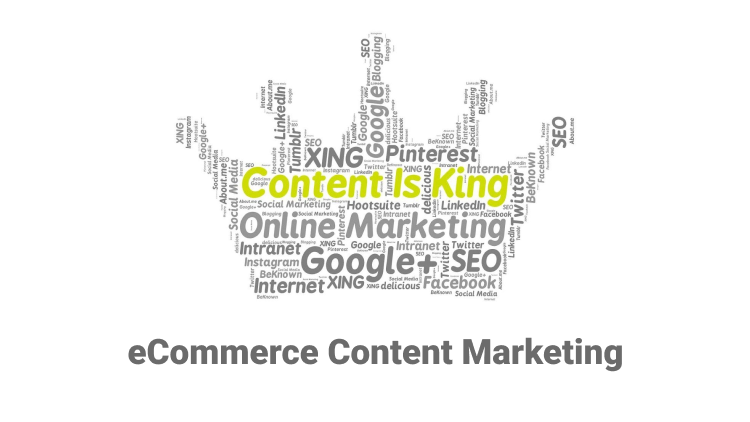- What Is Content Marketing?
- Why Do You Need Content Marketing?
- 5 Tips to Get Started with Your Content Marketing
- Why Is The eCommerce Content Marketing Strategy Recommended?
- Social Media Marketing and eCommerce Content Marketing
- Conclusion
Ecommerce content marketing is important in the fast-paced digital landscape. Ecommerce has revolutionized the way we shop, traditional marketing approaches are no longer sufficient to capture the attention and loyalty of customers.
Enter eCommerce content marketing—an innovative strategy that has become a game-changer for businesses looking to thrive in the competitive online marketplace.
What Is Content Marketing?
Content marketing is a strategic marketing approach that involves creating and distributing valuable, relevant, and consistent content. Which attracts and engages with your target audience.
It is a method of marketing that focuses on providing informative, entertaining, or educational content rather than directly promoting a product or service.
The goal of content marketing is to build trust, establish credibility, and ultimately drive profitable customer action.
Instead of using traditional advertising techniques that interrupt consumers, a solid content marketing strategy aims to provide value and establish a connection with the audience by delivering content that aligns with their interests, needs, and preferences.

Content marketing can take various forms, including blog posts, articles, videos, podcasts, infographics, social media posts, e-books, webinars, and more.
The content is designed to inform, entertain, inspire, or solve problems for the target audience, positioning the brand or organization as an expert or thought leader in its industry.
Why Do You Need Content Marketing for Your eCommerce Sites?
For any thriving e-commerce site, the key to survival lies in achieving conversions. The initial step involves generating substantial traffic to your store, followed by effectively converting that traffic into valuable leads and sales.
While traffic holds immense importance, it alone cannot sustain your business financially. Without conversions, the number of visitors becomes inconsequential. This is where content marketing plays a pivotal role, enabling you to elevate your conversion rate.
Through content, you can establish meaningful connections with your customers, fulfilling their desire for engagement. By successfully forging these connections, you not only enhance customer engagement and foster brand loyalty, but also experience a notable increase in conversions and sales, thus securing the longevity of your eCommerce business.
5 Tips to Get Started with Your Content Marketing Efforts
1. Choose a form of content
Avoid wasting valuable resources—time, money, and energy—by attempting to tackle all forms of content across numerous platforms simultaneously.
The most efficient way to start is by focusing on one aspect: a specific type of content and a single platform. The optimal choice depends on factors such as your product, service, niche market, and target audience.
However, if you find yourself unsure, beginning with email content is a recommended approach. Email marketing consistently yields the highest return on investment.
To further refine your focus, automated emails tend to outperform manual ones. Automated welcome emails, promotional emails, and event emails are common forms of email content marketing.
To swiftly initiate your content marketing journey, select the medium with which you feel most comfortable. If you feel email does not resonate with your target audience, that’s alright!

Are you familiar with incorporating a blog section into your eCommerce site and crafting engaging blog posts? Alternatively, do you have experience producing YouTube videos? Consider focusing on that.
Have you been creating audio clips for an extended period? Perhaps starting a podcast is the way to go. Choose the medium that you believe you can launch and sustain most effortlessly.
For example, B2C eCommerce content marketing strategy often involves social media platforms, video marketing, images, and illustrations. The most important is that the content resonates with your prospective customers.
2. Create Guides
There are two primary decisions to make when it comes to content sharing. The first is determining the channels through which you will distribute your content. The second is deciding what type of content to share.
An efficient and straightforward approach to commence your content marketing efforts is by creating guides specifically tailored for your customers. These guides can serve as valuable resources that provide instructions on product usage, assembly, or troubleshooting.
Additionally, they can offer comprehensive information about the services you provide. By developing customer-centric content that informs and addresses their questions, you can establish a foundation of trust. This, in turn, helps guide them through the purchasing process, moving them closer to the readiness-to-buy stage.
Furthermore, utilizing guides allows you to share updates about your products, ensuring customers stay informed. It is essential to utilize these guides as educational tools for your customers, rather than using them as promotional platforms.
Their purpose should be to demonstrate your dedication to educating and assisting your audience in making informed decisions.

Additionally, incorporating visuals is crucial. Consumers seek to understand how things operate and what they look like. They want to visualize product usage and maintenance procedures, enhancing their overall comprehension and engagement.
3. Produce Compelling Videos to Show What You Have to Offer
Given people’s strong visual orientation, it is a must to leverage the power of video for your e-commerce endeavors. Video marketing offers endless possibilities to enhance your online presence. From short and impactful ad campaigns to comprehensive webinars or even online courses, the options are vast.
Craft an attention-grabbing ad campaign that incorporates a compelling hook. To maximize its potential to go viral, it must be catchy and distinguish itself from the competition. Consider developing an online course or hosting a webinar, both of which are effective methods to engage your audience and drive e-commerce sales.
Interactive webinars, in particular, foster meaningful engagement by enabling real-time interactions with participants while simultaneously recording the session for future offerings.
Furthermore, there are dedicated platforms like Skillshare designed specifically for hosting and sharing on-demand online courses.

By utilizing video content in your e-commerce strategy, you can effectively captivate your audience, strengthen brand engagement, and unlock new avenues for business growth.
4. Share the Customer’s Stories
Sharing customer success stories is a no-brainer when it comes to your content marketing strategy.
By showcasing positive experiences from your customers, you not only demonstrate to potential customers that your product is loved by their peers but also leverage your customers’ content creation skills. The best part? It’s genuine, authentic, and cost-effective.
Consider sharing stories of customers who have successfully used your products or services. If you already have remarkable product reviews, reach out to those customers and request additional information or details. Look for stories that are unique, original, or inspirational, and seek permission to share the valuable insights you’ve gained from them.
Another effective approach is to create competitions that encourage customers to share stories, pictures, or videos that promote your product. By organizing a competition among fans, you can significantly enhance engagement and stimulate conversations surrounding your brand.
Utilizing customer success stories as part of your content marketing strategy not only builds trust and credibility but also harnesses the power of user-generated content. It is an excellent way to tap into the authentic experiences of your customers, foster brand advocacy, and generate buzz around your offerings.
5. Provide Case Studies
Simplifying the process of persuading potential customers can be achieved by incorporating case studies on your e-commerce website. These case studies should prominently showcase how your products or services effectively address the specific needs of your customers.
When individuals who share similar needs come across these compelling studies, it significantly increases the likelihood of their interest in purchasing from you as well.
Why Is The eCommerce Content Marketing Strategy Recommended?
E-commerce Content Marketing Improves Search Engine Optimization (SEO)
E-commerce sites gain a significant competitive edge through the implementation of a content strategy that focuses on search engines and search engine optimization.
By consistently producing and optimizing valuable content targeted around relevant keywords, you have the potential to attract organic search traffic which would typically require paid advertising expenses. This translates into substantial savings, considering the higher return on investment that SEO offers compared to pay-per-click (PPC) advertising.
Furthermore, a well-executed SEO strategy yields compounding benefits over time by generating sustained organic traffic, which leads to acquiring new customers and driving increased revenue. In contrast, paid media relies on continuous ad purchases, with traffic plummeting once the ads are no longer active.
The advantages of eCommerce SEO extend beyond improved search engine rankings, increased traffic, and cost savings.
E-commerce content marketing fulfills the customer journey
For eCommerce companies, it is essential to implement content marketing strategies that cover the entire customer journey map. Starting from the point when a prospect becomes aware of a problem, continuing through the purchase process, and extending to customer retention.
By developing content that effectively solves specific problems, educates prospects, or provides valuable information, your brand can maintain a presence at every stage of the customer journey.
If your content is confined solely to product pages, as is often the case with many eCommerce retailers, you may have limited touchpoints with customers, only engaging them during the final stages of their journey.
Consequently, this creates significant opportunities for competitors to step in and address your prospective customers’ needs throughout the majority of their buyer journey. Leaving you with notable gaps in your marketing efforts.
Is There a Connection Between Social Media Marketing and eCommerce Content Marketing?
Social media marketing and eCommerce content marketing are two intertwined strategies that play crucial roles in the success of online businesses. While they have distinct approaches, they work together synergistically to enhance brand visibility, customer engagement, and conversion rates within the eCommerce landscape.
Social media marketing entails harnessing the power of various platforms like Facebook, Instagram, Twitter, LinkedIn, and Pinterest to promote products, connect with the audience, and cultivate brand recognition.
It encompasses activities such as creating and sharing captivating content, running targeted ad campaigns, fostering community interactions, and leveraging social media analytics for performance evaluation.
On the other hand, eCommerce content marketing focuses on developing valuable, relevant, and compelling content. In order to attract, engage, and convert customers in the eCommerce space. This content can take the form of blog posts, product descriptions, videos, customer testimonials, guides, and infographics.
The primary objective is to provide useful information, address customer pain points, and showcase the value of products or services, ultimately establishing customer trust and driving purchase decisions.

Let’s explore how these two strategies intersect and complement each other:
- Content Distribution: Social media platforms serve as ideal channels for distributing and promoting eCommerce content. Businesses can share blog posts, product videos, infographics, and other content assets on their social media profiles to reach a wider audience and generate engagement.
- Customer Engagement: Social media platforms facilitate direct interaction between businesses and customers. Ecommerce brands can utilize social media to engage with their audience, respond to inquiries, gather feedback, and build relationships. This engagement helps in understanding customer preferences, refining content strategies, and enhancing the overall customer experience.
- Brand Awareness: Social media marketing significantly enhances brand visibility and recognition. By consistently sharing valuable content and promoting products on social platforms, eCommerce businesses can expand their reach, attract new customers, and establish a strong brand presence in the digital landscape.
- Influencer Collaborations: Social media influencers play a pivotal role in eCommerce marketing. Collaborating with relevant influencers who align with the brand’s values and target audience can amplify content reach, drive product recommendations, and foster trust among their followers.
- User-Generated Content (UGC): Social media platforms facilitate the sharing of user-generated content, such as customer reviews, testimonials, and experiences. Ecommerce businesses can leverage UGC to build social proof, enhance credibility, and encourage potential customers to make purchase decisions.
- Ad Campaigns: Social media advertising allows eCommerce businesses to precisely target specific audiences based on demographics, interests, and behaviors. Paid social media campaigns effectively promote products, special offers, and content assets, driving traffic, generating leads, and increasing conversions.
- Tracking and Analytics: Both social media marketing and eCommerce content marketing benefit from data analysis. By utilizing social media analytics and eCommerce tracking tools, businesses can measure the performance of their content, track conversions, and make data-driven optimizations to improve marketing strategies.
Conclusion
In conclusion, eCommerce content marketing has emerged as a powerful strategy to drive success in the digital landscape. By strategically creating and distributing valuable content throughout the customer journey, businesses can effectively attract, engage, and retain their target audience.
From raising awareness and building trust to guiding customers towards a purchase and fostering long-term loyalty, content marketing proves to be a versatile tool for eCommerce companies.
By leveraging various content formats, such as blog posts, videos, social media content, and customer success stories, brands can connect with their audience on multiple platforms and deliver meaningful experiences.
Content marketing not only allows businesses to showcase their expertise and unique value proposition but also enables them to address customer needs, educate prospects, and offer solutions to their pain points.
Furthermore, content marketing for eCommerce brings significant SEO benefits, generating organic traffic and lowering advertising costs compared to paid media. It complements the customer journey by filling the gaps and providing valuable touchpoints throughout the entire buying process.
FAQ
Content marketing is crucial for eCommerce because it allows businesses to establish their expertise, build trust, and differentiate themselves from competitors. It helps in raising brand awareness, attracting organic traffic, engaging customers throughout the buying journey, and fostering long-term customer relationships.
The most effective types of content for eCommerce content marketing may include informative blog posts, product tutorials, customer testimonials, engaging videos, visually appealing images, social media content, interactive quizzes, and guides or e-books relevant to the target audience’s interests and needs.
Ecommerce content marketing drives conversions and sales by educating, informing, and persuading customers.
By creating content that addresses customer pain points, provides solutions, showcases product benefits, and offers valuable insights, businesses can influence purchasing decisions, build trust, and enhance the overall customer experience, ultimately leading to increased conversions and sales.
The frequency of producing new content for eCommerce businesses depends on various factors, such as the industry, target audience, available resources, and content distribution channels.
It is generally recommended to maintain a consistent content publishing schedule to keep the audience engaged, but the specific frequency can vary. It’s important to prioritize quality over quantity and focus on creating content that provides value to the audience.



